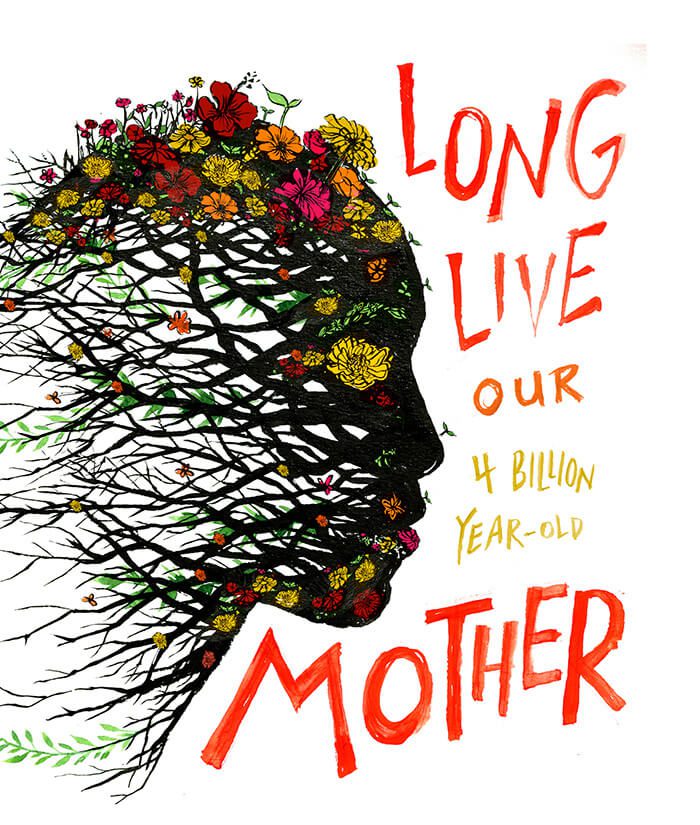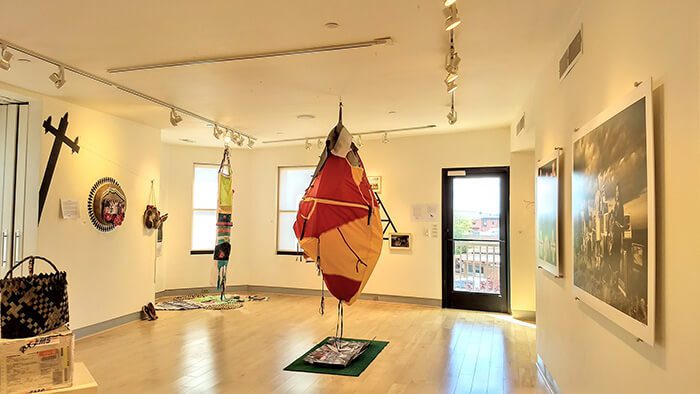
form & concept, Santa Fe
August 18 – October 28, 2017
The box can be a thing and an idea, sometimes diffuse, other times quite literally bounded. To think outside of one is a ready adage, one of those sayings that’s so overused it’s actually lost most of its ability to make a point. But when I think about the box in this exhibition, Broken Boxes, now on view at form and concept, the violence of categorization, not only of fitting in but being fit into a system wholly defined by someone else, comes to mind. Many of the Broken Boxes artists make assertions to the contrary, pushing up against the Western impetus to define so-called “others’” bodies, lands, and modes of (self) representation. Nanibah “Nani” Chacon makes art from actual boxes, exploding the cardboard vessel into a new surface for studying “positive and negative space for women” in her large-scale work Between a Black Cloud and a White Cloud He Found Her.
The exhibition Broken Boxes “honors the intersections where our stories overlap,” as co-curator Ginger Dunnill put it, just like its namesake, a podcast the sound artist and visual arts director of AHA Festival of Progressive Arts started in 2014. The podcast began with the aim of centering “Indigenous artists, activist-focused artists, Queer/Trans/NonBinary artists, women identifying artists, artists of color and mixed/lost/stolen heritage artists… to archive their stories, and to provide a platform for them to speak about their work and lives without any imposed narrative, or proposed approach to format.” If you listen, you hear artists telling their stories in their own words and relating where and how their creative practices fit in. Broken Boxes brings together forty of the artists previously interviewed, through a grant from the Fulcrum Fund, including Cannupa Hanska Luger, whose work can be viewed in the show, and who also made up the other half of the curatorial duo.
Demian DinéYazhi’’s This Land is Not Your Land, Was Not Your Land and Will Never Be Your Land, overturned the saccharine song I learned in elementary school, “This Land is Your Land,” into a dark and cutting provocation about histories of territoriality. The statement was overlaid onto a map of New Mexico, a gesture that resonates even more now during the season of Santa Fe’s Entrada and the most recent round of protests against the whitewashed reenactment. Then there was Douglas Miles’s Stop Anti-Native Violence, a dictum scrawled in the artist’s familiar hand style, learned in south Phoenix in the ’70s, and set alongside a portrait that brings to mind his brand, Apache Skateboards.

Just to the left was a photomural belonging to Chip Thomas, a doctor and artist renowned for creating pictures within pictures. You can see how he multiplies images in the many murals installed on walls throughout the Navajo Nation, which often speak of resource extraction on sovereign land. Jess X Snow’s TO SURVIVE, I TURNED MY BODY INTO A PRAYER FOR THE EARTH I-IV features images of a nude woman, one whose movements across white sand in some way dance the words she’s penned below. A screen in a corner room projects Amaryllis DeJesus Moleski’s Instructions for a Future, a gif-like video of a booty covered in third eyes sailing through a mythical cloudscape, magical glitter pouring from between the cheeks. A postal box filled with glitter sits in a vitrine nearby, reminding me of the wildly successful internet business, Ship Your Enemies Glitter. There are many tapestry-like forms in the show, including Freyr A. Marie’s Orchidd, a large scroll that runs down the wall with pink, hand-stitched words that speak of the glitch. Fauna, by Monica Caniloa, combines various shades of brown fabric (stockings, crochet pieces, and fabrics, all hand-dyed)—everyday detritus—into a hovering animal-like form that retains a domestic quality. I can imagine home was once somewhere in her finds.
Towards the end of the time I spent at form and concept, I tried multiple times to take a panorama photo as I stood a couple stairs down from the second floor. I ultimately failed, but I realized that, for the first time, I felt as if the space had been successfully engaged; there were intimate works that pulled me in but also art that cascaded from the ceiling, attached itself to walls like barnacles, settled into the corners, brought the outside in, and celebrated the booty in grand scale. It was as if the envelope of the gallery (another kind of box) was slowly being pulled apart, at least stretched to bear the voices of those compelled to break the box.



